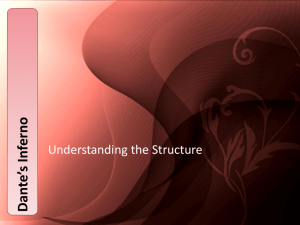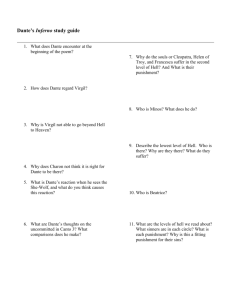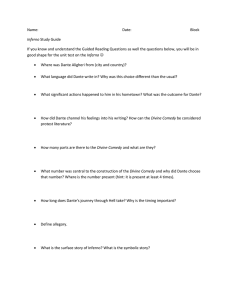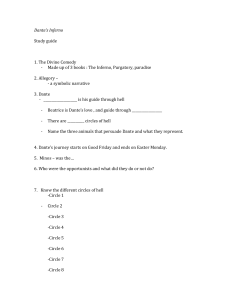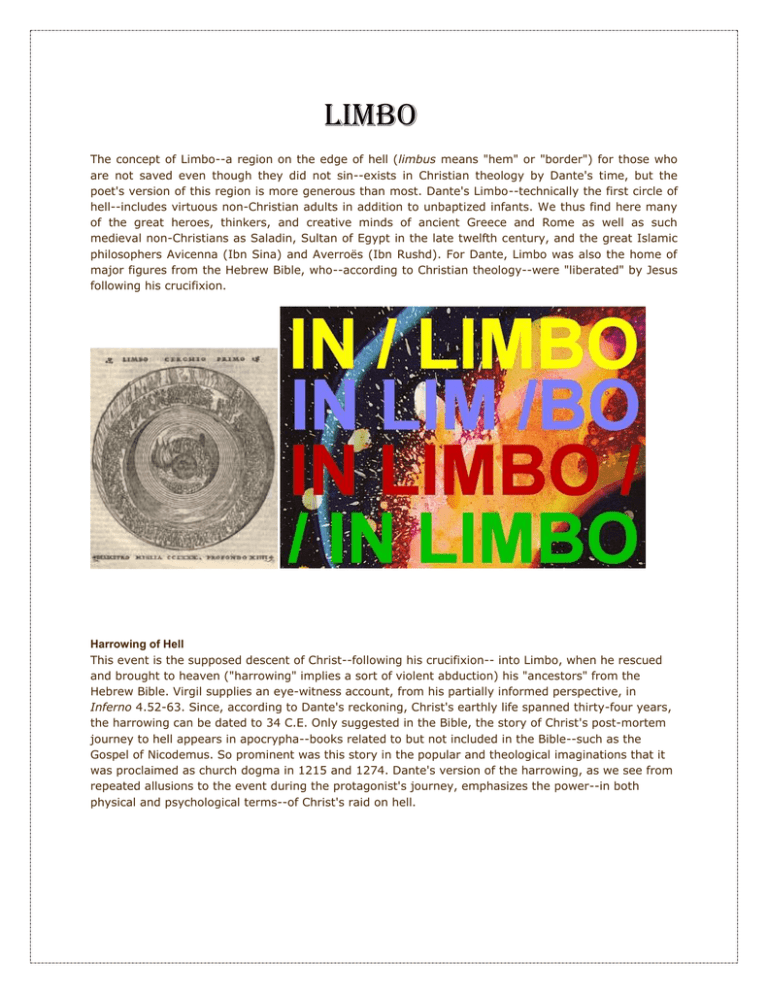
Limbo
The concept of Limbo--a region on the edge of hell (limbus means "hem" or "border") for those who
are not saved even though they did not sin--exists in Christian theology by Dante's time, but the
poet's version of this region is more generous than most. Dante's Limbo--technically the first circle of
hell--includes virtuous non-Christian adults in addition to unbaptized infants. We thus find here many
of the great heroes, thinkers, and creative minds of ancient Greece and Rome as well as such
medieval non-Christians as Saladin, Sultan of Egypt in the late twelfth century, and the great Islamic
philosophers Avicenna (Ibn Sina) and Averroës (Ibn Rushd). For Dante, Limbo was also the home of
major figures from the Hebrew Bible, who--according to Christian theology--were "liberated" by Jesus
following his crucifixion.
Harrowing of Hell
This event is the supposed descent of Christ--following his crucifixion-- into Limbo, when he rescued
and brought to heaven ("harrowing" implies a sort of violent abduction) his "ancestors" from the
Hebrew Bible. Virgil supplies an eye-witness account, from his partially informed perspective, in
Inferno 4.52-63. Since, according to Dante's reckoning, Christ's earthly life spanned thirty-four years,
the harrowing can be dated to 34 C.E. Only suggested in the Bible, the story of Christ's post-mortem
journey to hell appears in apocrypha--books related to but not included in the Bible--such as the
Gospel of Nicodemus. So prominent was this story in the popular and theological imaginations that it
was proclaimed as church dogma in 1215 and 1274. Dante's version of the harrowing, as we see from
repeated allusions to the event during the protagonist's journey, emphasizes the power--in both
physical and psychological terms--of Christ's raid on hell.
Lust
Here Dante explores the relationship--as notoriously challenging in his time and place as in ours-between love and lust, between the ennobling power of attraction toward the beauty of a whole
person and the destructive force of possessive sexual desire. The lustful in hell, whose actions often
led them and their lovers to death, are "carnal sinners who subordinate reason to desire" (Inf. 5.389). From the examples presented, it appears that for Dante the line separating lust from love is
crossed when one acts on this misguided desire. Dante, more convincingly than most moralists and
theologians, shows that this line is a very fine one indeed, and he acknowledges the potential
complicity (his own included) of those who promulgate ideas and images of romantic love through
their creative work. Dante's location of lust --one of the seven capital sins--in the first circle of hell in
which an unrepented sin is punished (the second circle overall) is similarly ambiguous: on the one
hand, lust's foremost location--farthest from Satan--marks it as the least serious sin in hell (and in
life); on the other hand, Dante's choice of lust as the first sin presented recalls the common--if crude-association of sex with original sin, that is, with the fall of humankind (Adam and Eve) in the garden
of Eden.
Famous Lovers (Semiramis, Dido, Cleopatra, Helen, Achilles, Paris, Tristan)
Physical beauty, romance, sex, and death--these are the pertinent elements in the stories of the
lustful souls identified from among the "more than a thousand" such figures pointed out to Dante by
Virgil (Inf. 5.52-69). Semiramis was a powerful Assyrian Queen alleged--by the Christian historian
Orosius--to have been so perverse that she made even the vice of incest a legal practice. She was
said to have been killed by an illegitimate son. Dido, Queen of Carthage and widow of Sychaeus,
killed herself after her lover, Aeneas, abandoned her to continue his mission to establish a new
civilization in Italy (Aeneid 4). Cleopatra, the beautiful Queen of Egypt, took her own life to avoid
capture by Octavian (the future emperor Augustus); Octavian had defeated Mark Antony, who was
Cleopatra's lover (she had previously been the lover of Julius Caesar). Helen, wife of Menalaus (King
of Sparta) was said to be the cause of the Trojan war: acclaimed as the most beautiful mortal woman,
she was abducted by Paris and brought to Troy as his mistress. The "great Achilles" was the most
formidable Greek hero in the war against the Trojans. He was killed by Paris, according to medieval
accounts (Dante did not know Homer's version), after being tricked into entering the temple of Apollo
to meet the Trojan princess Polyxena.
Gluttony
Gluttony--like lust--is one of the seven capital sins (sometimes called "mortal" or "deadly" sins)
according to medieval Christian theology and church practice. Dante, at least in circles 2-5 of hell,
uses these sins as part--but only part--of his organizational strategy. While lust and gluttony were
generally considered the least serious of the seven sins (and pride almost always the worst), the order
of these two was not consistent: some writers thought lust was worse than gluttony and others
thought gluttony worse than lust. The two were often viewed as closely related to one another, based
on the biblical precedent of Eve "eating" the forbidden fruit and then successfully "tempting" Adam to
do so (Genesis 3:6). Dante appears to view gluttony as more complex than the usual understanding of
the sin as excessive eating and drinking.
Avarice, & Prodigality
Avarice--greed, lust for material gain--is one of the iniquities that most incurs Dante's scornful wrath.
Consistent with the biblical saying that avarice is "the root of all evils" (1 Timothy 6:10), medieval
Christian thought viewed the sin as most offensive to the spirit of love; Dante goes even further in
blaming avarice for ethical and political corruption in his society. Ciacco identifies avarice--along with
pride and envy--as one of the primary vices enflaming Florentine hearts (Inf. 6.74-5), and the poet
consistently condemns greed and its effects throughout the Divine Comedy. Dante accordingly shows
no mercy--unlike his attitude toward Francesca (lust) and Ciacco (gluttony)--in his selection of avarice
as the capital sin punished in the fourth circle of hell (Inferno 7). He viciously presents the sin as a
common vice of monks and church leaders (including cardinals and popes), and he further degrades
the sinners by making them so physically squalid that they are unrecognizable to the travelers (Inf.
7.49-54). By defining the sin as "spending without measure" (7.42), Dante for the first time applies
the classical principle of moderation (or the "golden mean") to criticize excessive desire for a neutral
object in both one direction ("closed fists": avarice) and the other (spending too freely: prodigality).
Fittingly, these two groups punish and insult one another in the afterlife.
Wrath & sullenness
Like the fourth circle of hell, the fifth circle--presented in Inferno 7 and 8--contains two related groups
of sinners. But whereas avarice and prodigality are two distinct sins based on the same principle (an
immoderate attitude toward material wealth), wrath and sullenness are basically two forms of a single
sin: anger that is expressed (wrath) and anger that is repressed (sullenness). This idea that anger
takes various forms is common in ancient and medieval thought. Note how the two groups suffer
different punishments appropriate to their type of anger--the wrathful ruthlessly attacking one another
and the sullen stewing below the surface of the muddy swamp (Inf. 7.109-26)--even though they are
all confined to Styx.
Dante designates all of lower hell--circles 6 through 9, where more serious sins are punished--as the
walled city of Dis (Inf. 8.68), one of the names for the king of the classical underworld (Pluto) and--by
extension--the underworld in general. For Dante, then, Dis stands both for Lucifer and the lower
circles of his infernal realm. It may be significant that Virgil--a classical poet who refers to Dis in his
Aeneid--is the one who now announces the travelers' approach to Dis in the Divine Comedy. Details of
the city and its surroundings in Inferno 8 and 9--including moats, watch towers, high walls, and a
well-guarded entrance--suggest a citizenry ready for
Heresy
Dante opts for the most generic conception of heresy--the denial of the soul's immortality (Inf.
10.15)--perhaps in deference to spiritual and philosophical positions of specific characters he wishes to
feature here, or perhaps for the opportunity to present an especially effective form of contrapasso:
heretical souls eternally tormented in fiery tombs. More commonly, heresy in the Middle Ages was a
product of acrimonious disputes over Christian doctrine, in particular the theologically correct ways of
understanding the Trinity and Christ. Crusades were waged against "heretical sects," and individuals
accused of other crimes or sins--e.g., witchcraft, usury, sodomy--were frequently labeled heretics as
well.
Heresy, according to a theological argument based on the dividing of Jesus' tunic by Roman soldiers
(Matthew 27:35), was traditionally viewed as an act of division, a symbolic laceration in the
community of "true" believers.
Violence
Virgil explains to Dante that sins of violence take three forms according to the victim: other people
(one's neighbor), oneself, or God (Inf. 11.28-33). Those who perpetrate violence against other people
or their property--murderers and bandits--are punished in the first ring of the seventh circle, a river of
blood (Inferno 12). Those who do violence against themselves or their own property--suicides and
squanderers (more self-destructive than the prodigal in circle 4)--inhabit the second ring, a horrid
forest (Inferno 13). The third ring--inside the first two--is a barren plain of sand ignited by flakes of
fire that torment three separate groups of violent offenders against God: those who offend God
directly (blasphemers: Inferno 14); those who violate nature, God's offspring (sodomites: Inferno 1516); and those who harm industry and the economy, offspring of nature and therefore grandchild of
God (usurers: Inferno 17). Identifying the sins of these last two groups with Sodom and Cahors (Inf.
11.49-50), Dante draws on the biblical destruction of Sodom (and Gomorrah) by fire and brimstone
(Genesis 19:24-5) and the medieval condemnations of citizens of Cahors (a city in southern France)
for usury. Dante's emotional reactions to the shades in the seventh circle range from neutral
observation of the murderers and compassion for a suicide to respect for several Florentine sodomites
and revulsion at the sight and behavior of the lewd usurers.
Thomas Aquinas, warned that suicide violates the natural law of self-preservation, harms the
community at large, and usurps God's disposition of life and death. Dante's inclusion of sodomy-understood here as sexual relations between males but not necessarily homosexuality in terms of
sexual orientation.
Fraud: pimping & corruption
While all versions of fraud involve the malicious use of reason, circles 8 and 9 are distinguished from
one another according to the offender's relationship to his or her victim: those who victimize someone
with whom they share a special bond of trust (relatives, political / civic comrades, guests,
benefactors) are punished in the lowest circle; if there exists no bond besides the "natural" one
common to all humanity, the guilty soul suffers in one of the ten concentric ditches that constitute
circle 8.
Physically connected by bridges, the ditches of circle 8 contain fraudulent shades whose particular
vices and actions similarly serve to interconnect the cantos and their themes in this part of the poem.
Thus the pimps and seducers, whipped by horned demons in the first ditch, relate to the flatterers-disgustingly dipped in the excrement of the second ditch--through the sexualized figure of Thais, a
prostitute from the classical tradition who falsely praises her "lover" (Inf. 18.127-35). These first two
ditches are presented in a single canto (18). Images of degraded sexuality are even more prominent
in the next canto (19). Here Dante presents simony--the abuse of power within the church--as a form
of spiritual prostitution, fornication, and rape (Inf. 19.1-4; 55-7; 106-11), a perversion of the holy
matrimony conventionally posited between Christ (groom) and the church (bride). Political
corruption (fifth ditch), the crime for which Dante himself was falsely charged when he was forced
into exile, links back to similar abuses within the church (simony) and points ahead to the sin of
hypocrisy.
Treachery
Dante divides circle 9, the circle of treachery--defined in Inferno 11 as fraudulent acts between
individuals who share special bonds of love and trust (61-6)--into four regions. Caina is named after
the biblical Cain (first child of Adam and Eve), who slew his brother Abel out of envy after God showed
appreciation for Abel's sacrificial offering but not Cain's (Genesis 4:1-17)
Judecca, named after the apostle who betrayed Jesus (Judas Iscariot), is the innermost zone of the
ninth and final circle of hell. The term also hints at a manifestation of Christian prejudice--which Dante
certainly shares--against Judaism and Jews in the Middle Ages: it alludes to the names--Iudeca,
Judaica--for the area within certain cities (e.g., Venice) where Jews were forced to live, apart from the
Christian population. Together with Judas in this region of hell are others who, by betraying their
masters or benefactors, committed crimes with great historical and societal consequences. Completely
covered by the ice--like "straw in glass"--the shades are locked in various postures with no mobility or
sound whatsoever (Inf. 34.10-15).


